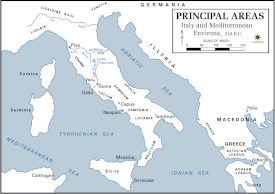
Back Derde Slaweoorlog Afrikaans حرب العبيد الثالثة Arabic حرب العبيد التالته ARZ Spartak üsyanı Azerbaijani اۆچونجو غلاملار ساواشی AZB Паўстанне Спартака Byelorussian Въстание на Спартак Bulgarian Tercera Guerra Servil Catalan سێیەم جەنگیی کۆیلەکان CKB Spartakovo povstání Czech
| Third Servile War | |||||||
|---|---|---|---|---|---|---|---|
| Part of the Servile Wars | |||||||
 Italy and surrounding territory, 218 BC | |||||||
| |||||||
| Belligerents | |||||||
| Rebel slaves | Roman Republic | ||||||
| Commanders and leaders | |||||||
| Strength | |||||||
| 120,000 escaped slaves and gladiators, including non-combatants; total number of combatants unknown |
| ||||||
| Casualties and losses | |||||||
41,000 killed
| ~20,000 killed | ||||||
The Third Servile War, also called the Gladiator War and the War of Spartacus by Plutarch, was the last in a series of slave rebellions against the Roman Republic known as the Servile Wars. This third rebellion was the only one that directly threatened the Roman heartland of Italy. It was particularly alarming to Rome because its military seemed powerless to suppress it.
The revolt began in 73 BC, with the escape of around 70 slave gladiators from a gladiator school in Capua. They easily defeated the small Roman force sent to recapture them, and within two years, they had been joined by some 120,000 men, women, and children. The able-bodied adults of this large group were a surprisingly effective armed force that repeatedly showed they could withstand or defeat the Roman military, from the local Campanian patrols to the Roman militia and even to trained Roman legions under consular command. This army of slaves roamed across Italy, raiding estates and towns with relative impunity, sometimes dividing into separate but connected bands with several leaders, including the famous former gladiator Spartacus.
The Roman Senate grew increasingly alarmed at the slave-army's depredations and continued military successes. Eventually Rome fielded an army of eight legions under the harsh but effective leadership of Marcus Licinius Crassus that destroyed the army of slaves in 71 BC. This happened after a long and bitter fighting retreat before the legions of Crassus and after the rebels realized that the legions of Pompey and Marcus Terentius Varro Lucullus were moving in to entrap them. The armies of Spartacus launched their full strength against Crassus's legions and were utterly defeated. Of the survivors, some 6,000 were crucified along the Appian Way.
Plutarch's account of the revolt suggests that the slaves simply wished to escape to freedom and leave Roman territory by way of Cisalpine Gaul. Appian and Florus describe the revolt as a civil war in which the slaves intended to capture the city of Rome. The Third Servile War had significant and far-reaching effects on Rome's broader history. Pompey and Crassus exploited their successes to further their political careers, using their public acclaim and the implied threat of their legions to sway the consular elections of 70 BC in their favor. Their actions as consuls greatly furthered the subversion of Roman political institutions and contributed to the transformation of the Roman Republic into the Roman Empire.